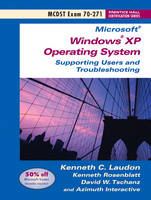
MCDST 70-271
Prentice Hall Certification (Verlag)
978-0-13-149989-8 (ISBN)
- Titel ist leider vergriffen;
keine Neuauflage - Artikel merken
MCDST Exam 70-271: Supporting Users and Troubleshooting a
Microsoft Windows XP Operating System
Table of Contents
Lesson 1: Developing a Troubleshooting Strategy
1.1 Developing a Troubleshooting Strategy
1.2 Discovering the Problem
1.3 Evaluating System Configuration
1.4 Tracking Possible Solutions
1.5 Executing a Plan and Checking Results
1.6 Taking a Proactive Stance
Lesson 2: Key Features to the Microsoft Windows XP Operating System
1.1 Introducing the Windows XP Family of Operating Systems
1.2 Identifying the Key Features of Windows XP Home Edition
1.3 Identifying the Key Features of Windows XP Professional Edition
1.4 Identifying the Range of Supported Software
1.5 Introducing Windows XP File Management Features
1.6 Introducing Windows XP Security Features
1.7 Introducing Workgroups and Domains
Lesson 3: Performing and Troubleshooting an Attended Installation of a Windows XP Operating System
3.1 Choosing Installation Methods
3.2 Identifying Preinstallation Tasks
3.3 Installing Windows XP Using a CD ROM
3.4 Installing Windows XP Over a Network
3.5 Using Setup Manager
3.6 Using the System Preparation Tool
3.7 Understanding Remote Installation Services
3.8 Upgrading from a Previous Version of Windows
Lesson 4: Performing and Troubleshooting an Unattended Installation of a Windows XP Operating System
4.1 Migrating User State Data from an Existing PC to a New PC
4.2 Installing a Second Instance of an Operating System on a Computer
4.3 Applying Service Packs
4.4 Customizing Installations for Individual Users
4.5 Updating Windows XP after Installation
Lesson 5: Performing and Troubleshooting Other Installation Tasks Related to Windows XP Operating Systems
5.1 Ascertaining the Probable Cause When an Installation Does Not Start
5.2 Ascertaining the Probable Cause When an Unattended Installation Does Not Complete
Lesson 6: Monitoring, Managing, and Troubleshooting Access to Files and Folders
6.1 Monitoring, Managing, and Troubleshooting NTFS File Permission
6.2 Monitoring, Managing, and Troubleshooting Simple File Sharing
6.3 Monitoring, Managing, and Troubleshooting File Encryption
Lesson 7: Monitoring, Managing, and Troubleshooting Access to Shared Folders
7.1 Creating Shared Folders
7.2 Configuring Access Permissions for Shared Folders on NTFS Partitions
7.3 Troubleshooting and Interpreting Access Denied Messages
7.4 Configuring and Troubleshooting Offline Files
7.5 Configuring and Troubleshooting Offline File Synchronization
Lesson 8: Connecting to Local and Network Print Devices
8.1 Adding a Local Printer
8.2 Configuring a Local Printer
8.3 Connecting to a Network Printer
8.4 Configuring a Network Printer
Lesson 9: Configuring and Troubleshooting Storage Devices
9.1 Understanding Different Storage Types on Hard Drives
9.2 Identifying the Properties of a Disk
9.2 Managing Disk Partitioning
9.3 Troubleshooting Disk Partitioning
9.4 Understanding Different Types of Optical Drives (such as CD-ROM, CD-RW, DVD, and DVD-R)
9.5 Configuring and Troubleshooting Removable Storage Devices Such as Pen Drives, Flash Drives, and Memory Cards
Lesson 10: Configuring, Managing, and Troubleshooting Display, Power, and I/O Devices
10.1 Setting Display Properties
10.2 Configuring Multiple Displays
10.3 Troubleshooting Display Settings
10.4 Configuring ACPI Settings
10.5 Configuring Operating System Power Settings
10.6 Configuring and Troubleshooting System Standby and Hibernate Settings
10.7 Configuring I/O Devices
10.8 Configuring and Troubleshooting Device Settings
10.9 Configuring and Troubleshooting Device Drivers for I/O Devices
10.10 Configuring and Troubleshooting Hardware Profiles
Lesson 11: Configuring and Troubleshooting the Desktop and User Environments
11.1 Configuring and Troubleshooting Task and Toolbar Settings
11.2 Configuring and Troubleshooting Accessibility Options
11.3 Configuring and Troubleshooting Pointing Device Settings
11.4 Configuring and Troubleshooting Fast-Use Switching
11.5 Configuring and Troubleshooting Regional settings
11.6 Configuring and Troubleshooting Language settings
Lesson 12: Security 12.1 Introducing Local Security Policies
12.2 Introducing Network Security Policies
12.3 Identifying End-User Issues Caused by Local Security Policies Such as Local Security Setting and Security Configuration and Analysis
12.4 Identifying End-User Issues Caused by Network Security Policies Such as Result Set of Policy and Group Policy
12.5 Configuring and Troubleshooting Local User Accounts
12.6 Configuring and Troubleshooting Local Group Accounts
12.7 Troubleshooting System Startup Problems
12.8 Troubleshooting Local User Logon Issues
12.9 Troubleshooting Domain User Logon Issues
Lesson 13: Monitoring and Analyzing System Performance
13.1 Monitoring System Performance
13.2 Configuring Alerts
13.3 Using Help and Support to Troubleshoot System Performance
13.4 Using Task Manger to Troubleshoot System Performance
13.5 Using the Performance Tool
Lesson 14: Troubleshooting TCP/IP and Name Resolution Issues
14.1 Identifying and Using TCP/IP Tools
14.2 Configuring and Troubleshooting Manual TCP/IP Configurations
14.3 Configuring and Troubleshooting Automated TCP/IP Configurations
14.4 Configuring and Troubleshooting Internet Connection Firewall (ICF)
14.5 Configuring and Troubleshooting Host Name Resolution Issues on a Client
14.6 Configuring and Troubleshooting NetBIOS Name Resolution
Lesson 15: Configuring and Troubleshooting Remote Connections
15.1 Configuring Outbound Connections
15.2 Creating a Dialup Connection
15.3 Configuring and Troubleshooting a Remote Dialup Connection
15.4 Setting up a VPN Connection
Lesson 16: Configuring and Troubleshooting Internet Explorer
16.1 Configuring and Troubleshooting IE Connection Properties
16.2 Configuring and Troubleshooting IE Security Properties
16.3 Configuring and Troubleshooting IE General Properties
Lesson 17: Configuring and Troubleshooting End-User Systems Using Remote Tools
17.1 Understanding Remote Desktop and Remote Assistance
17.2 Using Remote Desktop
17.3 Using Remote Assistance
| Verlagsort | Upper Saddle River |
|---|---|
| Sprache | englisch |
| Maße | 275 x 210 mm |
| Gewicht | 1084 g |
| Themenwelt | Informatik ► Betriebssysteme / Server ► Windows |
| ISBN-10 | 0-13-149989-0 / 0131499890 |
| ISBN-13 | 978-0-13-149989-8 / 9780131499898 |
| Zustand | Neuware |
| Haben Sie eine Frage zum Produkt? |
aus dem Bereich


